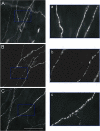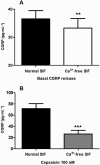Evidence for CGRP re-uptake in rat dura mater encephali
- PMID: 20804493
- PMCID: PMC3010590
- DOI: 10.1111/j.1476-5381.2010.01012.x
Evidence for CGRP re-uptake in rat dura mater encephali
Abstract
Background and purpose: Calcitonin gene-related peptide (CGRP) is widely distributed in the trigeminovascular system and released from sensory fibres of the cranial dura mater upon noxious stimulation. Such release may be a mechanism underlying migraine headache. Based on data from guinea pig basilar artery preparations, we have here studied CGRP release and uptake in an organ preparation of the hemisected rat skull.
Experimental approach: CGRP release from the cranial dura was quantified by a commercial enzyme-linked immunoassay. CGRP was depleted using repetitive challenges of capsaicin. After incubating the tissue with CGRP for 20 min and extensive washing, another capsaicin challenge was performed. Immunohistochemistry was used to visualize CGRP immunofluorescence in dural nerve fibres.
Key results: Capsaicin-induced CGRP release was attenuated by the transient receptor potential vanilloid receptor type I antagonist capsazepine or by Ca(2+)-free solutions. After the CGRP-depleted preparation had been exposed to exogenous CGRP, capsaicin-induced CGRP release was increased compared to the challenge just prior to incubation. CGRP uptake was not influenced by Ca(2+)-free solutions. Olcegepant and CGRP(8-37) (CGRP receptor antagonists) did not affect uptake of CGRP. However, a monoclonal CGRP-binding antibody decreased CGRP uptake significantly. Release of CGRP after incubation was attenuated by Ca(2+)-free solutions and by capsazepine. Immunohistochemical assays indicated a weak trend towards CGRP uptake in rat dura mater.
Conclusion and implications: We have presented evidence for CGRP uptake in nerves and its re-release in rat dura mater. This may have implications for the pathophysiology and treatment of migraine.
© 2010 The Authors. British Journal of Pharmacology © 2010 The British Pharmacological Society.
Figures










Similar articles
-
Endovanilloids are potential activators of the trigeminovascular nocisensor complex.J Headache Pain. 2016;17:53. doi: 10.1186/s10194-016-0644-7. Epub 2016 May 17. J Headache Pain. 2016. PMID: 27189587 Free PMC article.
-
Vanilloid type 1 receptors (VR1) on trigeminal sensory nerve fibres play a minor role in neurogenic dural vasodilatation, and are involved in capsaicin-induced dural dilation.Br J Pharmacol. 2003 Oct;140(4):718-24. doi: 10.1038/sj.bjp.0705486. Br J Pharmacol. 2003. PMID: 14534154 Free PMC article.
-
Capsaicin-sensitive neurogenic sensory vasodilatation in the dura mater of the rat.J Physiol. 2003 Nov 1;552(Pt 3):859-67. doi: 10.1113/jphysiol.2003.050633. Epub 2003 Aug 29. J Physiol. 2003. PMID: 12949222 Free PMC article.
-
Neuropeptide effects in the trigeminal system: pathophysiology and clinical relevance in migraine.Keio J Med. 2011;60(3):82-9. doi: 10.2302/kjm.60.82. Keio J Med. 2011. PMID: 21979827 Review.
-
CGRP receptors in the control of pain and inflammation.Curr Opin Pharmacol. 2009 Feb;9(1):9-14. doi: 10.1016/j.coph.2008.12.007. Epub 2009 Jan 20. Curr Opin Pharmacol. 2009. PMID: 19157980 Review.
Cited by
-
Mode and site of action of therapies targeting CGRP signaling.J Headache Pain. 2023 Sep 11;24(1):125. doi: 10.1186/s10194-023-01644-8. J Headache Pain. 2023. PMID: 37691118 Free PMC article. Review.
-
Chemical mediators of migraine: preclinical and clinical observations.Headache. 2011 Jun;51(6):1029-45. doi: 10.1111/j.1526-4610.2011.01929.x. Headache. 2011. PMID: 21631491 Free PMC article. Review.
-
Effects of Calcitonin-Gene-Related-Peptide on Auditory Nerve Activity.Front Cell Dev Biol. 2021 Nov 12;9:752963. doi: 10.3389/fcell.2021.752963. eCollection 2021. Front Cell Dev Biol. 2021. PMID: 34869340 Free PMC article.
-
Therapeutic use of botulinum toxin in migraine: mechanisms of action.Br J Pharmacol. 2014 Sep;171(18):4177-92. doi: 10.1111/bph.12763. Br J Pharmacol. 2014. PMID: 24819339 Free PMC article. Review.
-
Lasmiditan inhibits calcitonin gene-related peptide release in the rodent trigeminovascular system.Pain. 2020 May;161(5):1092-1099. doi: 10.1097/j.pain.0000000000001801. Pain. 2020. PMID: 31977930 Free PMC article.
References
Publication types
MeSH terms
Substances
LinkOut - more resources
Full Text Sources
Other Literature Sources
Research Materials
Miscellaneous

